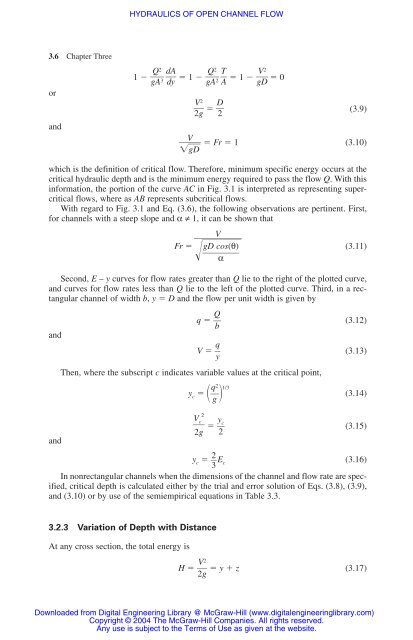chapter 3 hydraulics of open channel flow
chapter 3 hydraulics of open channel flow
chapter 3 hydraulics of open channel flow
You also want an ePaper? Increase the reach of your titles
YUMPU automatically turns print PDFs into web optimized ePapers that Google loves.
3.6 Chapter Three<br />
or<br />
and<br />
Q2<br />
1 � �� gA3<br />
� dA<br />
Q2<br />
T V2<br />
� � 1 � �� dy<br />
gA2<br />
�� � 1 � �g � � 0<br />
A D<br />
V2<br />
�� � �<br />
2g<br />
D<br />
� (3.9)<br />
2<br />
�<br />
V<br />
� � Fr � 1 (3.10)<br />
�g�D�<br />
which is the definition <strong>of</strong> critical <strong>flow</strong>. Therefore, minimum specific energy occurs at the<br />
critical hydraulic depth and is the minimum energy required to pass the <strong>flow</strong> Q. With this<br />
information, the portion <strong>of</strong> the curve AC in Fig. 3.1 is interpreted as representing supercritical<br />
<strong>flow</strong>s, where as AB represents subcritical <strong>flow</strong>s.<br />
With regard to Fig. 3.1 and Eq. (3.6), the following observations are pertinent. First,<br />
for <strong>channel</strong>s with a steep slope and α ≠ 1, it can be shown that<br />
V<br />
��<br />
Fr � (3.11)<br />
�� g � D � c<br />
�α o � s(<br />
� θ � ) ��<br />
Second, E – y curves for <strong>flow</strong> rates greater than Q lie to the right <strong>of</strong> the plotted curve,<br />
and curves for <strong>flow</strong> rates less than Q lie to the left <strong>of</strong> the plotted curve. Third, in a rectangular<br />
<strong>channel</strong> <strong>of</strong> width b, y � D and the <strong>flow</strong> per unit width is given by<br />
q � � Q<br />
� (3.12)<br />
b<br />
and<br />
and<br />
HYDRAULICS OF OPEN CHANNEL FLOW<br />
V � � q<br />
�<br />
y<br />
Then, where the subscript c indicates variable values at the critical point,<br />
(3.13)<br />
yc � �� q2<br />
�� g<br />
1/3<br />
(3.14)<br />
� V<br />
2<br />
c<br />
� � �<br />
2g<br />
yc<br />
�<br />
2<br />
(3.15)<br />
yc � � 2<br />
3 � Ec (3.16)<br />
In nonrectangular <strong>channel</strong>s when the dimensions <strong>of</strong> the <strong>channel</strong> and <strong>flow</strong> rate are specified,<br />
critical depth is calculated either by the trial and error solution <strong>of</strong> Eqs. (3.8), (3.9),<br />
and (3.10) or by use <strong>of</strong> the semiempirical equations in Table 3.3.<br />
3.2.3 Variation <strong>of</strong> Depth with Distance<br />
At any cross section, the total energy is<br />
V2<br />
H � �� � y � z (3.17)<br />
2g<br />
Downloaded from Digital Engineering Library @ McGraw-Hill (www.digitalengineeringlibrary.com)<br />
Copyright © 2004 The McGraw-Hill Companies. All rights reserved.<br />
Any use is subject to the Terms <strong>of</strong> Use as given at the website.

















